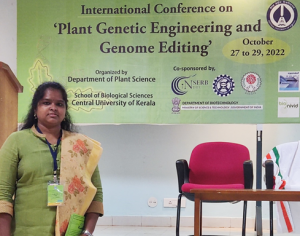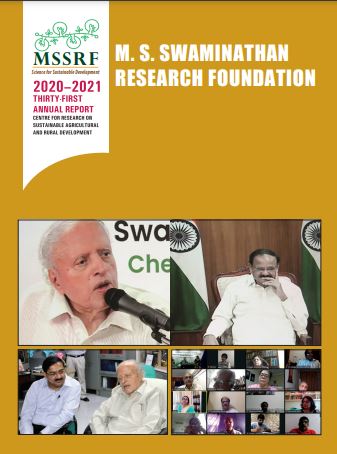Presenting innovative research on Avicennia marina from her doctoral thesis work at MSSRF
Ms Balasundari D is a Ph D scholar with the Biotechnology Programme at MSSRF. She was one of the many speakers presenting research work at the international conference on Plant Genetic Engineering and Genome Editing hosted by the Central University of Kerala, Kasaragod from October 27 – 29, 2022.
Speaking to her, we discover that her work is rather unique and had several members of the audience showing keen interest in on-going research. Like all researchers, Balasundari too shies away from gallant displays until the results are published, so even a sneaky view was restricted.
She opened up a little about how there were senior scientists who asked a couple of questions after her eight-minute presentation, and was happy that many researchers both online and in person wanted to understand why she chose the specimen Avicennia marina for her research.
It could be that it is mandatory for scholars to present their on-going work in at least two conference-type forums during the PhD trajectory, and this was Balasundari’s first chance, but what remains with her is the interest from peers and other participants at the international conference.
Hers was an oral presentation titled: Adventitious root development strategies during propagule establishment in the pioneering mangrove species Avicennia marina

This is a snapshot of her talk:
| Seeds of A. marina (often also called propagules) show embryonic development on the parent tree before detachment. This phenomenon is called ‘crypto-vivpary’ and allows premature seedling development that is an adaptive mechanism to excess salinity in the soil. After the A. marina ’propagule’ detaches from the tree, it falls in tidal mudflats where rapid adventitious root development is a pre-requisite for seedling anchorage against hydrodynamic forces (waves and currents).
In the study, A. marina seedling and root morphological traits were noted and anatomical measurements of root tissues were recorded. The study showed that angular positioning of three roots numbered R1-R3 to form a triad (120° with respect to each other) may be important for overall seedling balance, weight distribution and therefore anchorage against tidal action. |
Balasundari interacted with scientists across the world and listend to plenary as well as special lectures on genome editing and abiotic stress tolerance, plus attending a NGS genomics workshop at the conference.

